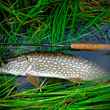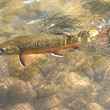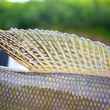I am an unabashed wild trout snob. And I'm not alone. Many others would also proudly proclaim themselves to be so because, put simply, wild trout are better in every way than their stocked counterpart. Wild trout are typically stronger, faster, more wily, more feisty and often considerably more beautiful. Stocked trout, on the other hand, so often underwhelm. As strangers to the environment they've found themselves planted in, having been raised in a tank and fed with pellets, they behave unnaturally, rarely present us with challenges and teach us little that will allow us to become better anglers. They bore us with their snubbed noses and tattered fins. And so wild trout snobs like myself seek out waters where wild trout predominate. For those of us that live in the east, this often comes often at the expense of convenience, fish size or both. But it's worth it.
Yet, despite my disdain for stocked trout, I have a soft spot for holdovers, those ill-equipped transplants that beat the odds by leveraging instinct and likely more than a bit of luck to persist through the winter and cement themselves as full fledged residents of the waters they swim in.
Even in big, bug-rich tailwaters, stocked trout that make it through a full year to greet the bucket loads of their brethren that get dumped in come spring earn a measure of respect. Regardless of the plentiful food supply and abundance of good lies, these holdovers have still defied their likely fate. In unwelcoming, icy mountain freestoners like one I recently fished — where the food supply is scarce even in the height of summer — holdover trout inspire a significant amount of awe.
This particular small mountain creek tumbles through northeastern Pennsylvania, cutting small gorges and deep pools as it makes its way down the mountainside, rolling over boulders. Its waters stay cold throughout the summer, making them trout-friendly, but lack plentiful nutrition. Native brook trout persist, uniquely adapted to the environment. In addition to the natives, the stream is stocked each spring by a local club with brown and brook trout, most of which end up downstream in larger streams and rivers, harvested by anglers or simply fail to adapt to the rigors of the real world. Each year, however, a few specimens persist, some for several seasons in a row.

When the opportunity presents itself, I like to visit the this creek early in the spring, after much of the winter's ice has cleared but before the spring stocking, in search of those native trout and the hardy browns and brookies that have made it through the winter. After this winter, one of the harshest on record, I wasn't expecting much. But to my delight, not only was I greeted by holdovers that had somehow found a way persist through the seasons, I found the small creek as rich with early season life as I have ever seen it.
Each brook and brown trout that I was able to draw out fought the lethargy induced by the still-icy spring waters, overcome by the hunger of an unusually long winter. I found myself mystified by each fish that came to hand, in awe of the tenacity that allowed it to make it through the harsh season from which the creek had only just emerged. And on that day, the stockers outshone the wild fish they shared the stream with. These stocked, but holdover fish, had become wild in their own right, now more fish of the stream than of the tank. In this particular environment, that transformation required no small feat.






























Comments